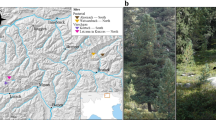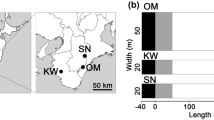Abstract
Post-fire Pezizales fruit commonly in many forest types after fire. The objectives of this study were to determine which Pezizales appeared as sporocarps after a prescribed fire in the Blue Mountains of eastern Oregon, and whether species of Pezizales formed mycorrhizas on ponderosa pine, whether or not they were detected from sporocarps. Forty-two sporocarp collections in five genera (Anthracobia, Morchella, Peziza, Scutellinia, Tricharina) of post-fire Pezizales produced ten restriction fragment length polymorphism (RFLP) types. We found no root tips colonized by species of post-fire Pezizales fruiting at our site. However, 15% (6/39) of the RFLP types obtained from mycorrhizal roots within 32 soil cores were ascomycetes. Phylogenetic analyses of the 18S nuclear ribosomal DNA gene indicated that four of the six RFLP types clustered with two genera of the Pezizales, Wilcoxina and Geopora. Subsequent analyses indicated that two of these mycobionts were probably Wilcoxina rehmii, one Geopora cooperi, and one Geopora sp. The identities of two types were not successfully determined with PCR-based methods. Results contribute knowledge about the above- and below-ground ascomycete community in a ponderosa pine forest after a low intensity fire.

Similar content being viewed by others
References
Agee JK (1998) Fire and pine ecosystems. In: Richardson DM (ed) Ecological biogeography of pines. Cambridge University Press, Cambridge, pp 193–218
Agerer R (1987–1998) Color atlas of ectomycorrhizae. Eindhorn, Schwäbish Gmund, pp 4–16
Baar J, Horton TR, Kretzer AM, Bruns TD (1999) Mycorrhizal colonization of Pinus muricata from resistant propagules after a stand-replacing wildfire. New Phytol 143:409–418
Burdsall HH (1968) A revision of the genus Hydnocystis (Tuberales) and the hypogeous species of Geopora (Pezizales). Mycologia 60:496–525
Buscot F (1994) Ectomycorrhizal types and endobacteria associated with ectomycorrhizas of Morchella elata (Fr.) Boudier with Picea abies (L.) Karst. Mycorrhiza 4:223–232
Cullings KW, Vogler DR (1998) A 5.8S nuclear ribosomal RNA gene sequence database: applications to ecology and evolution. Mol Ecol 7:919–923
Dahlstrom JL, Smith JE, Weber NS (2000) Mycorrhiza-like interaction by Morchella with species of the Pinaceae in pure culture. Mycorrhiza 9:272–279
Danielson RM (1982) Taxonomic affinities and criteria for identification of the common ectendomycorrhizal symbiont of pines. Can J Bot 60:7–18
Danielson RM (1984) Ectomycorrhizae formation by the operculate discomycete Sphaerosporella brunnea (Pezizales). Mycologia 76:454–461
Egger KN (1986) Substrate hydrolysis patterns of post-fire ascomycetes (Pezizales). Mycologia 78:771–780
Egger KN (1995) Molecular analysis of ectomycorrhizal fungal communities. Can J Bot 73 [Suppl]:S1415-S1422
Egger KN (1996) Molecular systematics of E-strain mycorrhizal fungi: Wilcoxina and its relationship to Tricharina (Pezizales). Can J Bot 74:773–779
Egger KN, Paden JW (1986) Biotrophic associations between lodgepole pine seedlings and post-fire ascomycetes (Pezizales) in monoxenic culture. Can J Bot 64:2719–2725
Egger KN, Danielson RM, Fortin JA (1991) Taxonomy and population structure of E-strain mycorrhizal fungi inferred from ribosomal and mitochondrial DNA polymorphisms. Mycol Res 95:866–872
Gardes M, Bruns TD (1993) ITS primers with enhanced specificity for basidiomycetes-application to the identification of mycorrhizae and rusts. Mol Ecol 2:113–118
Gardes M, Bruns TD (1996a) Community structure of ectomycorrhizal fungi in a Pinus muricata forest: above- and below-ground views. Can J Bot 74:1572–1583
Gardes M, Bruns TD (1996b) ITS-RFLP matching for identification of fungi. Methods Mol Biol 50:177–186
Gardes M, White TJ, Fortin JA, Bruns TD, Taylor JW (1991) Identification of indigenous and introduced symbiotic fungi in ectomycorrhizae by amplification of nuclear and mitochondrial ribosomal DNA. Can J Bot 69:180–190
Gargas A, DePriest PT (1996) A nomenclature for fungal PCR products with examples from intron-containing SSU rDNA. Mycologia 88:745–748
Gehring CA, Theimer TC, Whitham TG, Keim P (1998) Ectomycorrhizal fungal community structure of pinyon pines growing in two environmental extremes. Ecology 79:1562–1572
Hobbie EA, Weber NS, Trappe JM (2001) Determining mycorrhizal or saprotrophic status of fungi from isotopic evidence: implications for element cycling and fungal evolution. New Phytol 150:601–610
Hobbie EA, Weber NS, Trappe JM, van Klinken GJ (2002) Using radiocarbon to determine the mycorrhizal status of fungi. New Phytol 156:129–136
Horton TR (2002) Molecular approaches to ectomycorrhizal diversity studies: variation in ITS at a local scale. Plant Soil 244:29–39
Horton TR, Bruns TD (2001) The molecular revolution in ectomycorrhiza ecology: peeking into the black-box. Mol Ecol 10:1855–1871
Horton TR, Cázares E, Bruns TD (1998) Ectomycorrhizal, vesicular-arbuscular and dark septate fungal colonization of bishop pine (Pinus muricata) seedlings in the first five months of growth after wildlife. Mycorrhiza 8:11–18
Kårén O, Högberg N, Dahlberg A, Jonsson L, Nylund JE (1997) Inter- and intraspecific variation in the ITS region of rDNA of ectomycorrhizal fungi in Fennoscandia as detected by endonuclease analysis. New Phytol 136:313–325
Laiho O (1965) Further studies on ectendotrophic mycorrhiza. Acta For Fenn 79:1–35
Lee SB, Taylor JW (1990) Isolation of DNA from fungal mycelia and single spores. In: Innis MA, Gelfand DH, Sninsky JJ, White TJ (eds) PCR protocols: a guide to methods and applications. Academic Press, New York, pp 282–87
Maia LC, Yano AM, Kimbrough JW (1996) Species of Ascomycota forming ectomycorrhizae. Mycotaxon 57:371–390
Mikola P (1965) Studies on the ectendotrophic mycorrhiza of pine. Acta For Fenn 79:5–56
Mikola P, Laiho O, Erikäinen J, Kuvaja K (1964) The effect of slash burning on the commencement of mycorrhizal association. Acta For Fenn 77:2–12
Norman JE, Egger KN (1996) Phylogeny of the genus Plicaria and its relationship to Peziza inferred from ribosomal DNA sequence analysis. Mycologia 88:986–995
Petersen PM (1970) Danish fireplace fungi: an ecological investigation of fungi on burns. Dansk Bot Arkiv 27:1–97
Smith SE, Read DJ (1997) Mycorrhizal symbiosis, 2nd edn. Academic Press, San Diego
Spatafora JW, Volkmann-Kohlmeyer B, Kohlmeyer J (1998) Independent terrestrial origins of the Halosphaeriales (marine Ascomycota). Am J Bot 85:1569–1580
States JS, Gaud WS (1997) Ecology of hypogeous fungi associated with ponderosa pine. I. Patterns of distribution and sporocarp production in some Arizona forests. Mycologia 89:712–726
Stendell ER, Horton TR, Bruns TD (1999) Early effects of prescribed fire on the structure of the ectomycorrhizal fungal community in a Sierra Nevada ponderosa pine forest. Mycol Res 103:1353–1359
Swofford DL (1993) PAUP: phylogenetic analysis using parsimony, version 3.1. Computer program distributed by the Illinois Natural History Survey, Champaign, Ill.
Swofford DL (1999) PAUP*. Phylogenetic analysis using parsimony (*and other methods), version 4. Sinauer, Sunderland, Mass.
Taylor AFS (2002) Fungal diversity in ectomycorrhizal communities: sampling effort and species detection. Plant Soil 244:19–28
Thies WG, Niwa CG, Westlind DG (2001) Impact of prescribed fire in ponderosa pine stands in the southern Blue Mountains on various components of the ecosystem—three years post fire. In: Marshall K (ed) Proceedings of the forty-ninth annual Western International Forest Disease Work Conference. 16–20 September 2001, Carmel, Calif. USDA Forest Service, Central Point, Ore., pp 108–112
Visser S, Danielson RM, Parkinson D (1981) Respiratory activity of some mycorrhizal and non-mycorrhizal fungi in pure culture. In: Proceedings of the 5th North American Conference on Mycorrhizae, p 59
Vrålstad T, Holst-Jensen A, Schumacher T (1998) The postfire discomycete Geopyxis carbonaria (Ascomycota) is a biotrophic root associate with Norway spruce (Picea abies) in nature. Mol Ecol 7:609–616
Warcup JH (1990) Occurrence of ectomycorrhizal and saprophytic discomycetes after a wild fire in a eucalypt forest. Mycol Res 94:1065–1069
White TJ, Bruns TD, Lee SB, Taylor JW (1990) Amplification and direct sequencing of fungal ribosomal RNA genes for phylogenetics. In: Innis MA, Gelfand DH, Sninsky JJ, White TJ (eds) PCR protocols: a guide to methods and application. Academic Press, New York, pp 315–321
Yang CS, Korf RP (1985) A monograph of the genus Tricharina and of a new, segregate genus, Wilcoxina (Pezizales). Mycotaxon 24:467–531
Yang CS, Wilcox HE (1984) An E-strain ectendomycorrhiza formed by a new species, Tricharina mikolae. Mycologia 76:675–684
Yu TE J-C, Egger KN, Peterson RL (2001) Ectendomycorrhizal associations—characteristics and functions. Mycorrhiza 11:167–177
Acknowledgements
We thank Keith Egger for his advice on E-strain fungi; Yana Valachovic and Bob Peck for field assistance; Art Fredeen, Annette Kretzer, and Hugues Massicotte for helpful comments on the paper. We are grateful to Chris Niwa and Walt Thies for coordinating research treatments, and to the Emigrant Creek Ranger District (previously the Burns Ranger District), especially Buddy Crisafi, Fire Manager, for help and timely burning of the stands. This study was funded by the USDA Forest Service, Pacific Northwest Research Station. Collections made by N.S. Weber were funded by National Science Foundation grants DEB 9007186 and BSR 9400545.
Author information
Authors and Affiliations
Corresponding author
Rights and permissions
About this article
Cite this article
Fujimura, K.E., Smith, J.E., Horton, T.R. et al. Pezizalean mycorrhizas and sporocarps in ponderosa pine (Pinus ponderosa) after prescribed fires in eastern Oregon, USA. Mycorrhiza 15, 79–86 (2005). https://doi.org/10.1007/s00572-004-0303-8
Received:
Accepted:
Published:
Issue Date:
DOI: https://doi.org/10.1007/s00572-004-0303-8




